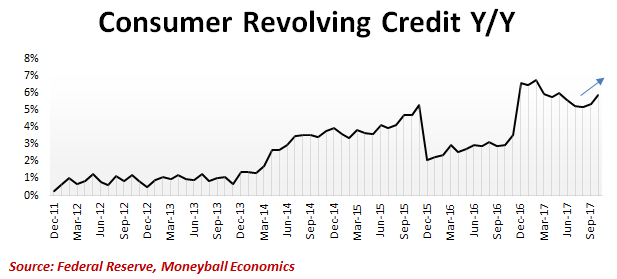US Consumer spending is accelerating again. Just in time for the Holiday Season. Consumer confidence is driving a boost in holiday spending.

(Note: The Vice Index is lagged 5 months)
November Sees Several Positive Spending Tailwinds
For starters, holiday shopping started early: rather than wait for Black Friday in late November, many retailers started offering sales in early November.
Other positive trends were:
- Mild weather: mild weather brings out more shoppers.
- New iPhone will add to sales
- Solid macroeconomic conditions: The economy moved at a steady pace.
One major headwind was the reversal of the hurricane recovery spending. From auto sales to furniture. Building materials and appliances. Hurricane recovery spending pushed up retail.
You may also like US Retail Companies Have a Massive Bill to Pay Come 2018
Now it’s reversing and that will be a drag.
Households Spending Beyond Everyone’s Means
The pace of consumption exceeds the pace of compensation.
It’s a signal suggesting consumer confidence. It’s typically seen in post-recession recovery periods.
Against the background of steadily decelerating Compensation growth, does this mean that consumers are confident about future wage growth? Maybe not.
I’ll tell you now, household finances are not healthy:
Credit card spending (revolving debt) has been accelerating the last few months.
The savings rate is bouncing off the lowest levels since the recovery began.
The savings rate is most noteworthy because, as the above charts shows, it tends to plunge in the run-up to recessions. Meaning that households struggle to keep up their lifestyles and must tap into their savings.
Food Services spending echoes that pullback in savings.
In short, households are borrowing against the future. Because they must. And because they feel that they can.
No doubt the strong stock and housing markets are adding to the willingness to spend.
One last data point to consider: consumer goods imports rose again (largely on smartphones). Retailers are seeing strong demand and have boosted imports: October imports tend to be November sales.
A Split Economy?
It’s likely the US has an economy where the upper-income families are doing well but the lower income households are under more stress.
Non-farm Payrolls reflects a trend where higher-paying white collar jobs have picked up this year whereas lower-paying jobs (temp workers, Retail, Leisure & Hospitality) have been stagnant in the second half.
Is that getting picked up in consumer discretionary spending?
Well, consider diamond purchases. After trending down throughout 2015, prices strengthened for diamonds 1 carrot and larger.
But the sweet spot for lower-income buyers is the smaller 0.5ct-1ct. And prices not only continued their downward trend, they are about to turn negative.
Gambling Slips Again
Gambling continues to reflect a pullback in fun-money spending.
There’s just no growth. No doubt real-world inflation (oil is up 20%+ for the year) is weighing on lower-income gamblers.
Key Takeaway: Black Friday was a massive confidence booster for all those looking at the health of the consumer. But peel back the curtain, and you see a different picture starting to unfold. The consumer is weakening. You can see it through the discretionary spending from gambling is decreasing. Consumers continue to plunge further into debt. All while savings rates are trending down.
The jury isn’t out. But there are major warning signs. 2018 will be an interesting year.












